Do you have an efficient landscape? You know, one that kicks in when temperatures soar and there isn’t a rain event in the forecast for days.
As our climate changes, it’s more important than ever to conserve water into the soil so healthy plants can continue to grow and thrive. Healthy plants are the backbone of our lives. They are integral to the lifecycle that grows our food and contributes to our well-being.
All it takes is just a little bit of planning.
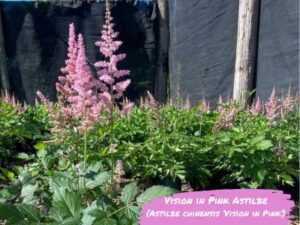
Vision in Pink Astilbe (Astilbe Chinensis ‘Vision in Pink’)
Plant for Waterwise
Look for opportunities to create a sustainable landscape – one that uses water efficiently and effectively, so plants work for you rather than the other way around. The goal is to retain water in the soil, which helps plants grow healthy, strong root systems. These function like straws, pulling up beneficial nutrients through moisture in the soil.
Waterwise plants survive on less moisture than most landscape plants because they have adapted over time to the region in which they’re grown. They are the workhorses of the garden. Once established, waterwise plants have no fuss, no muss and can stand up to summer’s heat with nary a droop.
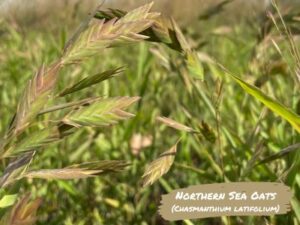
Northern Sea Oats (Chasmanthium Latifolium)
Northern Sea Oats, for example, thrive wherever they’re planted. Give them full sun or throw them some shade. They are drought tolerant and don’t mind having their feet wet. They’re also salt tolerant, deer resistant and low maintenance.
Plan for Where to Plant
Don’t be a “plunker!” That’s someone who buys a plant, drops it in the ground, and hopes for the best. If you’ve heard the saying “right plant, right place,” it applies to sustainable landscape planting as well as to planting in sun or shade.
High and low spots on the property are opportunities to conserve water by making the best of it as a planting site. Make note of where these areas are, as well as how water flows into the property’s groundwater drainage system. That right there is your planting guide for conserving water and directing it back to the plants.
Add a Rain Garden
Where water pools after a heavy rainfall is the right place for a rain garden.

Rocket Ligularia (Ligularia Stenocephala ‘The Rocket’)
Add native plants and grasses like Rocket Ligularia and Blazing Star to shallow depressions that are slower to drain. Instead of running off into streets or sidewalks, water filters through layers of soil and eventually flows into the groundwater system. Rain gardens provide food and shelter for birds, butterflies, bees and other wildlife.
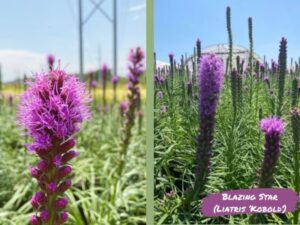
Blazing Star (Liatris ‘Kobold’)
At 4 feet tall, Rocket Ligularia has lemon-yellow flowers that shoot straight up above enormous, heart-shaped green leaves. Its mounded habit won’t have it any other way except wet and shady. Similarly, Blazing Star likes moist soils but full sun to support its lavender-pink spikes – beacons to butterflies, hummingbirds and pollinators.
Take Advantage of Slopes
Higher areas of the landscape that feature slopes will benefit from plants, ornamental grasses and shrubs that have dense root systems. This keeps slopes neat and tidy and helps prevent soil erosion.
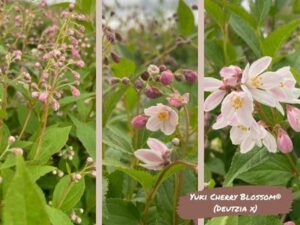
Yuki Cherry Blossom (Deutzia x)
Sun-loving and deer resistant, Yuki Cherry Blossom Deutzia performs especially well on slopes. Its compact height and spread is only about two feet at maturity, so this deutzia makes a good groundcover at the front of a border. Bonus is its delicate pink blossoms in spring.
Add Water Properly
To reduce water consumption, many municipalities and state and local governments will soon impose outdoor watering restrictions on homeowners and businesses. To conserve water – and make it work for you – experts advise watering in the early morning. This prevents the day’s hot, bright sun from drying out the soil.
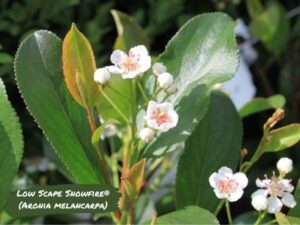
Low Scape Snowfire® (Aronia Melancarpa)
Low Scape Snowfire® has pretty, glossy-green leaves that are the backdrop to delicate white flowers in spring. In summer, they are the show before turning bright red in autumn.
For many shrubs, foliage is the star that makes it a three- or four-season plant. Keep foliage and flowers from holding onto water and turning brown in the hot summer sun. Hand watering at soil level is always best.
For most established plants, trees and shrubs, provide up to one inch of water (or 0.62 gallons) per week. To further help the soil retain moisture, add a layer of organic leaf or shredded hardwood bark mulch.
Learn More About Loma Vista Nursery and Our Landscape Plants
Loma Vista Nursery expertly grows a variety of waterwise perennials, trees and shrubs for Midwest independent garden centers, landscape contractors and wholesale distributors. Visit our plant catalog.
Review our website to learn about our values and best-practices as a Midwest plant grower.
Our staff members are experts in the field who love helping people learn and understand more about plants. To get help with your orders and answers to plant-related questions, send an email to sales@lomavistanursery.com or call (785) 229-7200.
Connect With Us
Stay current on our plant recommendations, growing tips and more by following us on social media.
